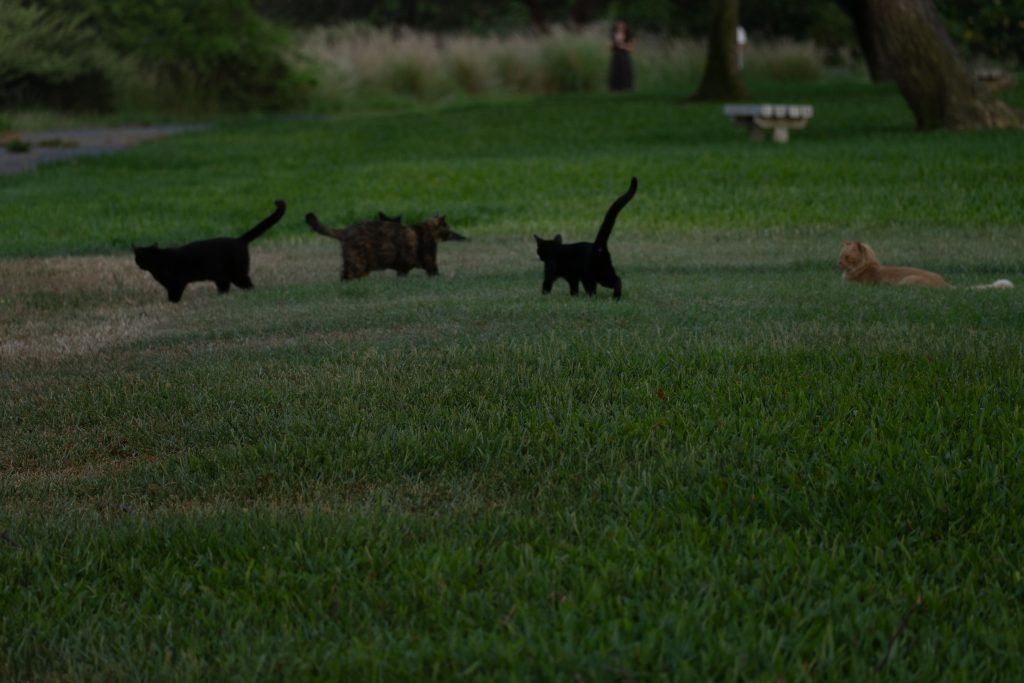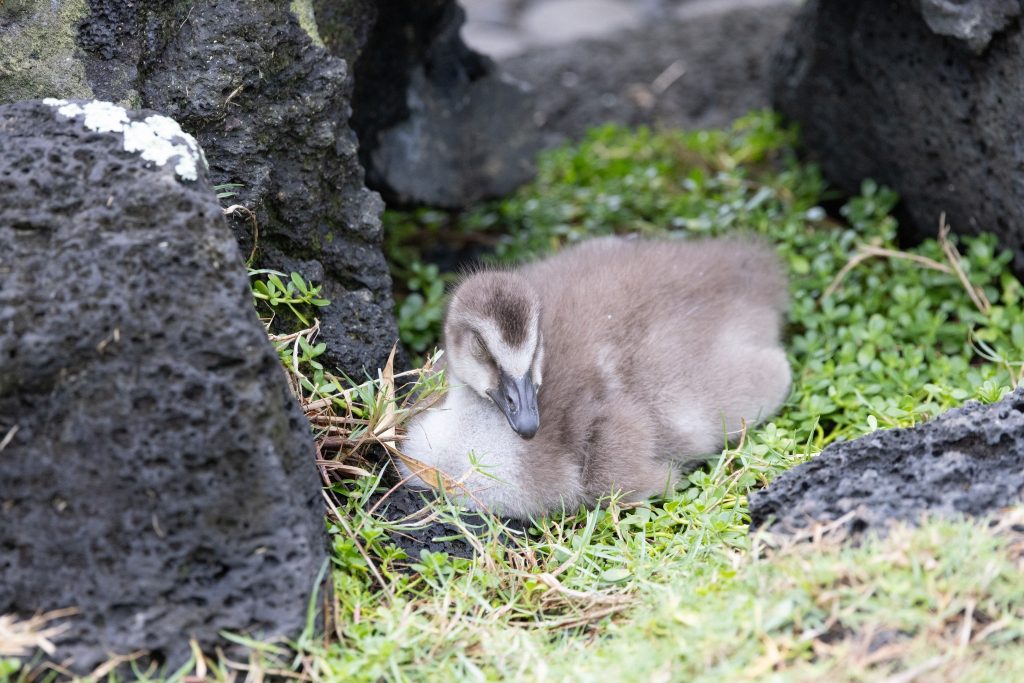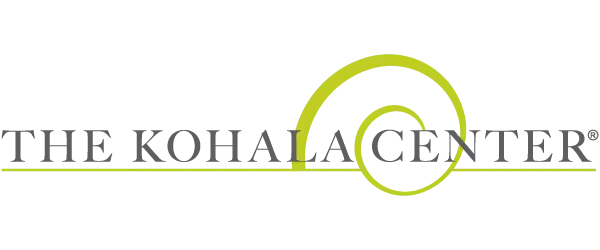It may soon be illegal to feed feral cats, pigs, other stray animals on Hawai‘i County property
A committee of the Hawaiʻi County Council voted on Tuesday to recommend passage of a bill that would make it illegal to feed feral or stray animals at parks and on other property owned by Hawai’i County.
With the 7-1 vote in favor of Bill 51 by the Policy Committee on Health, Safety and Wellbeing, it now moves to the full council (made up of the same members) to be considered for passage.
The vote came after the committee listened to two hours of passionate testimony for and against the measure, which also received a lot of written testimony. Council Member Jenn Kagiwada was the only no vote on the bill, expressing concern about its enforceability. Council Member Ashley Kierkiewicz was absent.

If the bill is passed, someone caught feeding feral animals, including cats, pigs, chickens and goats, could face a fine of $50 for the first violation and $500 for additional violations.
Those supporting the measure say feeding these feral cats threatens native endangered species like the nēnē, Hawaiʻi’s official state bird, and the Hawaiian monk seal because their feces carry a deadly parasite called toxoplasmosis.
Those against the bill say stopping the feeding is inhumane and would increase the impact on wildlife because the felines would be forced to roam for food.
“Cutting off their food supply would only force the cats to hunt and scavenge, worsening the very problems the ordinance aims to fix,” Jeanne Alford said in written testimony to the County Council.
County Parks and Recreation Director Clayton Honma said while cats are a big concern, including the 600 cats in and around Lili‘uokalani Gardens, other feral animals also cause problems.
“It’s chickens and pigs tearing up our ballfields in county parks,” Honma said. “We have issues everywhere.”
At one park, Honma said a sand pit meant for beach volleyball can’t be used because it’s been a feral pig “litterbox” for years.
The bill does not address if the animals would be removed from county property, where they would go, or how the proposed rule would be enforced.
Matthew Runnells, director of Hawai‘i County’s Animal Control and Protection Agency, said he doesn’t think the bill solves the issue of feral animals on county property. If the feeding stops, he explained, the populations will migrate.
“We need to figure out a method of removing these animals,” Runnells said.
When council members asked Runnells about enforcement, the director said it would be difficult, citing a manpower issue. His department only has 10 officers who respond to cases islandwide.
Runnells also said the county doesn’t take in healthy stray cats that were trapped by a member of the public because they don’t have space in the shelters. He thinks a sanctuary could serve that function of taking in unwanted animals.
The bill doesn’t single out any specific animal. But on Tuesday, most of the testimony centered around the cat colonies that exist throughout the island.
Many testifiers against the bill said the cats are abandoned on county properties, like parks and transfer stations, because people know the animals will be fed.
“It’s not a cat problem, it’s a human problem,” one testifier stated.
Alford, who has managed a small, stable colony of seven feral cats through a trap-neuter-return program for 12 years, noted that proper feeding and care lead to healthier animals, fewer nuisance complaints and smaller colonies over time.

“These cats are all spayed or neutered, vaccinated and monitored,” Alford wrote. “The only way this effort has remained successful — and humane — is through consistent feeding.”
Sandra Alstrand, a board member for the nonprofit Action for Animals, has worked for years with animal rescue organizations and feeds a colony of community cats. She described the measure as a frivolous waste of resources.
“These cats are not our enemy, as this bill seems to imply,” Alstrand stated in written testimony. “They are cats that were abandoned by people, either their owners or people who don’t want them on their property. This is a despicable practice, however, there really are no alternatives for these poor cats.”
Alstrand said animal control doesn’t take in cats from the community because drop-offs and animal sanctuaries are full.
“Until we address the problem of overpopulation with more free spay and neuter clinics, we will always have an overpopulation of cats (and dogs),” Alstrand stated.
Those supporting the bill pointed to the death of a 1-month-old nēnē gosling in 2024 that was found in Lili‘okalani Gardens, a county park in Hilo, with toxoplasmosis in its system.
One testifier, who ives in Keaukaha and frequents the county parks, said during the committee meeting that the bill would restore balance to Hawai‘i Island’s “fragile ecosystem.” She added: “I’m dismayed that there is a preference given to feral cats over the state bird, the nēnē.”
The testifier said she has seen piles of cat food that have become deadly traps to other animals.
Another testifier at the meeting said the feeding of cats empowers non-native predators in Hawai‘i to take over. She said she doesn’t think the bill is about punishing compassion, but preventing the deaths of native species.
Council Member Matthew Kaneali‘i-Kleinfelder, who introduced the bill, said the measure isn’t about a lack of compassion or a starvation bill.
“I’m not an animal hater,” Kaneali‘i-Kleinfelder said. “I have three cats, three dogs. I have 30 chickens. I have two peacocks. I have tilapia and goldfish. I love animals.”
Kaneali‘i-Kleinfelder said while he appreciated the concern about the feral animals, “I can’t logically say to kill the bill and expect things to change. … We have endangered species that we’re trying to protect and you cannot say that the cats don’t impact the nēnē.”
Kaneali‘i-Kleinfelder presented an amendment, at the suggestion of the Parks and Recreation Department, that would allow the county to continue working with nonprofits on the trap and neuter programs.
Council member Rebecca Villegas said there shouldn’t be feral cat colonies on this island.
“I have seen and heard the arguments that were made here today about responsible capture, spay and neuter, and release being a viable option, and all I have seen is our feral cat colonies increase,” Villegas said.
The councilwoman said the county needs to ensure the public spaces are safe and healthy for everyone.
Kagiwada opposed the bill, expressing concerns about putting another county code in place that won’t be regularly enforced. But she added: “I do think we need to do something. We can’t do nothing.”











